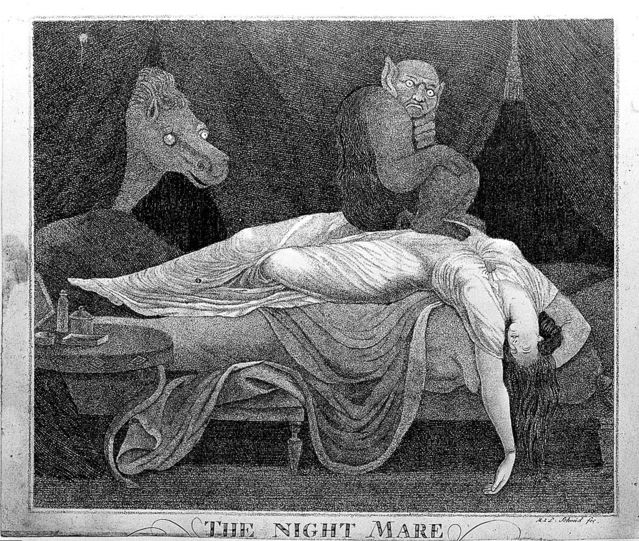Sleep
Treating Nightmare Disorder
Several effective treatments are available to treat nightmares.
Posted December 31, 2018

Nicky appeared fatigued and out of sorts. She seemed to have some difficulty concentrating on my questions. She had presented to the sleep clinic with disturbed sleep and daytime fatigue that included drowsiness while driving, a very alarming symptom. She noted that she had been under a great deal of stress at work and was concerned about her best friend who was going through a divorce. She had been helping her friend out by providing some coverage in the care of her ill and elderly mother. She found these visits to be very tiring and stressful but felt she had to help her friend any way she could. Nicky not only could not sleep through the night; she was also increasingly fearful of even going to bed. This was because for several months she had been having nightly, terrible nightmares that woke her and left her feeling anxious and distressed. She was also worried about insomnia. Nicky had become afraid to go to sleep, and then when she finally fell asleep, she’d at some point wake up terrified from the nightmares. After that, despite exhaustion she wouldn’t be able to get back to sleep for a very long time. During the day her fatigue blended into a toxic emotional experience of low mood with a constant edge of anxiety. She had a vague sense of fear that something bad could happen to her or to her friend and she was often troubled by memories of terrifying images from her nightmares. She desperately needed help with her Nightmare Disorder.
Nightmare Disorder often develops in the context of stress and disrupted sleep and is estimated to affect 4% of the adult population (Morgenthaler, Auerbach, Casey, Kristo, Maganti, Ramar, & Zak,2018). Successful treatment of Nightmare Disorder has been associated with improved quality of sleep, decreased fatigue, decreased daytime drowsiness, feeling more rested upon awakening, and decreased insomnia. A number of years ago a special committee of the American Academy of Sleep Medicine surveyed the literature and made recommendations on the treatment of this disorder (Aurora, Zak, Auerbach, Casey, Chowdhuri, Karippot, Maganti, Ramar, Kristo, Bista, Lamm, & Morgenthaler, 2010).
The most recent recommendations (Morgenthaler et al, 2018) focus on the treatment of nightmares that are associated with PTSD, and nightmares when they constitute a separate disorder. For treatment of nightmares associated with PTSD, some evidence was found for the effectiveness of cognitive behavioral therapy; cognitive behavioral therapy of insomnia; EMDR; image rehearsal therapy; and exposure, relaxation, and rescripting therapy. The strongest evidence was for image rehearsal therapy. Most of these treatments address the PTSD with a secondary benefit being the potential for relieving the distress of the associated nightmares. Exposure, relaxation, and rescripting therapy, and image rehearsal therapy both directly address the nightmares themselves. More about this below.
Numerous medications have been used in the treatment of nightmares associated with PTSD including olanzapine, risperidone, clonidine, fluvoxamine, gabapentin, prazosin, trazodone; and tricyclic antidepressants as well as several other agents. The most well researched and most often used is prazosin. It is used for treatment of high blood pressure, anxiety, and PTSD. I will discuss it further below. Olanzapine and risperidone are atypical antipsychotics and are most often used in the treatment of psychotic disorders. Clonidine is used to treat high blood pressure as well insomnia, ADHD, and anxiety disorders. Fluvoxamine is an antidepressant used to treat depression, OCD, and anxiety. Gabapentin is used for treatment of seizures and neuropathic pain. Trazodone and the tricyclic antidepressants are used for treatment of depression and, especially for trazodone, insomnia.
For Nightmare Disorder where the nightmares are not associated with PTSD, a number of psychological treatments have been used including cognitive behavioral therapy; exposure, relaxation, and rescripting therapy; hypnosis; lucid dreaming therapy; progressive muscle relaxation; sleep dynamic therapy; self-exposure therapy; and systematic desensitization. A number of medications have been used for treatment of nightmares alone. There has been less research on the use of medications to treat Nightmare Disorder than for nightmares associated with PTSD. These include prazosin and triazolam. Triazolam is used for treatment of insomnia and is known by the brand name Halcion. Prazosin is the best researched and most widely prescribed drug for treating nightmares in the practice of sleep medicine.
Prazosin works by reducing sympathetic outflow from the brain. Reducing this arousal is why it theoretically can help in the treatment of PTSD and a number of studies have documented its effectiveness. When used in the treatment of PTSD, reductions in nightmares have typically been found to be greater than with placebo. It is the first line choice for pharmacologic therapy of nightmares.
Image rehearsal therapy (IRT) is a cognitive behavioral therapy technique that is designed to displace the content of a nightmare (Aurora et al, 2010). Dream content and images are written down from memory. The theme, story, and ending of the nightmare is then re-written to be more positive. The new dream scenario is practiced 10 to 20 minutes per day while the patient is awake. Studies cited by (Morgenthaler et al, 2018) indicate that this method can be effective for a majority of patients and can significantly reduce the frequency of nightmares and the effect appears to be long lasting. Patients I have worked with have found it to be an effective treatment approach.
Exposure, relaxation and rescripting therapy (ERRT) is a modified form of Image rehearsal therapy and does not have as much research backing as IRT (Morgenthaler et al, 2018). This treatment targets the anxiety associated with the nightmares (Aurora et al, 2010) and uses psychoeducation, sleep hygiene, and progressive muscle relaxation techniques. The nightmares themselves are recalled and written down so that they can be rescripted as a form of exposure therapy. Additional techniques, as would be used for treatment of anxiety, such as problem solving and use of coping strategies, are used as well. As with IRT, this treatment can reduce the frequency and intensity of nightmares (Morgenthaler et al, 2018).
Less research has been done on lucid dreaming therapy than IRT or ERRT (Morgenthaler et al, 2018). It is a form of cognitive restructuring that uses lucid dreaming. This allows the patient to learn to alter the dream sequence during the nightmare itself (Aurora et al, 2010). This therapy shows promise in reducing or eliminating nightmares (Morgenthaler et al, 2018).
There is some limited research evidence for the use of sleep dynamic therapy in the treatment of nightmares (Morgenthaler et al, 2018). It is a combination of standard evidence-based sleep medicine therapies and instructions such as sleep hygiene, information on sleep quality, and stimulus control (Aurora et al, 2010). This approach also shows promise in reducing nightmares and appears to be long lasting (Morgenthaler et al, 2018).
Self-exposure therapy is a form of systematic desensitization. It involves recalling nightmare story lines and arranging them into a list based on increasing levels of anxiety. The patient then imagines each of the scenarios in order. The patient practices each scenario at their own rate moving from less anxiety provoking ones to more anxiety provoking ones until the associated fear is decreased (Aurora et al, 2010). This is done daily and a journal of the experience is kept. This method showed lasting decreases in nightmares in several studies (Morgenthaler et al, 2018).
These therapies, primarily psychological and behavioral in nature, offer hope that Nightmare Disorder and the nightmares associated with PTSD can be treated. Prazosinhas also shown demonstrated effectiveness for the treatment of nightmares. Nicky pursued a course of Image rehearsal therapy along with a trial of prazosin and showed considerable improvement in her Nightmare Disorder. Although she still has an occasional nightmare, they no longer plague her nights and leave her exhausted and anxious during the day. If you are suffering with frequent and troubling nightmares, discuss it with your primary care physician. Referral to a sleep clinic may be indicated. You don’t need to stay on the recurring nightmare merry-go-round. One or more of these treatments may work for you.

References
Aurora, R. N., Zak, R. S., Auerbach, S. H., Casey, K. R., Chowdhuri, S., Karippot, A., Maganti, R. K., Ramar, K., Kristo, D. A., Bista, S. R., Lamm, C. I., Morgenthaler, T. I., (2010). Best practice guide for the treatment of nightmare disorder in adults. Journal of Clinical Sleep Medicine, 6(4), p. 389-401.
Morgenthaler TI, Auerbach S, Casey KR, Kristo D, Maganti R, Ramar K, Zak R, Kartje R. (2018).Position paper for the treatment of nightmare disorder in adults: an American Academy of Sleep Medicine position paper. Journal of Clinical Sleep Medicine, 14(6), p. 1041–1055, doi.org/10.5664/jcsm.7178.




